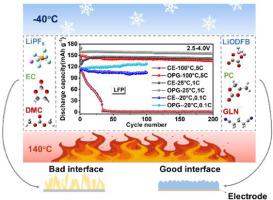Electrochimica Acta ( IF 5.5 ) Pub Date : 2022-06-10 , DOI: 10.1016/j.electacta.2022.140698 Bingying Zhu , Xiaotang Shi , Tianle Zheng , Jianwei Xiong , Ya-Jun Cheng , Yonggao Xia

|
Lithium secondary battery with a wide working temperature range is crucial to boost its increasing applications in harsh circumstances. Suppressing excessive electrolyte decomposition at high temperatures while maintaining reasonable electrochemical kinetics at low temperatures is critical for wide-temperature electrochemical performance. Construction of high temperature stable electrode-electrolyte interface layer by electrolyte formulation is an effective strategy to prevent electrolyte from uncontrollable decomposition. On the contrary to conventional thinking, propylene carbonate (PC) bearing poor filming ability to suppress electrolyte decomposition is used in this work to promote decomposition of the single lithium difluoro(oxalate)borate (LiODFB) salt in the electrolyte, producing inorganic-rich interface layer with good structure stability over a wide temperature range. Glutaronitrile (GLN) is further utilized to minimize the decomposition of PC by expelling PC out of the solvation sheath of lithium-ion. The teamwork of LiODFB, PC, and GLN makes a synergistic contribution to building a high-temperature stable electrode-electrolyte interface layer at both LFP and MCMB electrodes. Based on the approach developed in this work, the temperature window is successfully expanded to the range of from -40 °C to 140 °C. Excellent electrochemical performance is exhibited by both LFP/Li and MCMB/Li cells from -20 °C to 100 °C in terms of reversible capacity and cyclic stability.
中文翻译:

无用的用处:宽温电解质的团队合作使LFP / Li电池从-40°C到140°C
具有宽工作温度范围的锂二次电池对于促进其在恶劣环境中的应用至关重要。抑制高温下的过度电解质分解,同时在低温下保持合理的电化学动力学对于宽温电化学性能至关重要。通过电解质配方构建高温稳定的电极-电解质界面层是防止电解质不可控分解的有效策略。与传统思路相反,本工作采用成膜能力较差的碳酸丙烯酯(PC)抑制电解液分解,促进电解液中单二氟(草酸)硼酸锂(LiODFB)盐的分解,制备在宽温度范围内具有良好结构稳定性的富含无机物的界面层。戊二腈 (GLN) 进一步用于通过将 PC 从锂离子的溶剂化鞘中排出来最大限度地减少 PC 的分解。LiODFB、PC 和 GLN 的团队合作为在 LFP 和 MCMB 电极上构建高温稳定的电极-电解质界面层做出了协同贡献。基于这项工作中开发的方法,温度窗口成功地扩展到 -40 °C 到 140 °C 的范围。LFP/Li 和 MCMB/Li 电池在 -20 °C 至 100 °C 的可逆容量和循环稳定性方面均表现出优异的电化学性能。戊二腈 (GLN) 进一步用于通过将 PC 从锂离子的溶剂化鞘中排出来最大限度地减少 PC 的分解。LiODFB、PC 和 GLN 的团队合作为在 LFP 和 MCMB 电极上构建高温稳定的电极-电解质界面层做出了协同贡献。基于这项工作中开发的方法,温度窗口成功地扩展到 -40 °C 到 140 °C 的范围。LFP/Li 和 MCMB/Li 电池在 -20 °C 至 100 °C 的可逆容量和循环稳定性方面均表现出优异的电化学性能。戊二腈 (GLN) 进一步用于通过将 PC 从锂离子的溶剂化鞘中排出来最大限度地减少 PC 的分解。LiODFB、PC 和 GLN 的团队合作为在 LFP 和 MCMB 电极上构建高温稳定的电极-电解质界面层做出了协同贡献。基于这项工作中开发的方法,温度窗口成功地扩展到 -40 °C 到 140 °C 的范围。LFP/Li 和 MCMB/Li 电池在 -20 °C 至 100 °C 的可逆容量和循环稳定性方面均表现出优异的电化学性能。温度窗口成功扩展到-40°C至140°C的范围。LFP/Li 和 MCMB/Li 电池在 -20 °C 至 100 °C 的可逆容量和循环稳定性方面均表现出优异的电化学性能。温度窗口成功扩展到-40°C至140°C的范围。LFP/Li 和 MCMB/Li 电池在 -20 °C 至 100 °C 的可逆容量和循环稳定性方面均表现出优异的电化学性能。











































 京公网安备 11010802027423号
京公网安备 11010802027423号